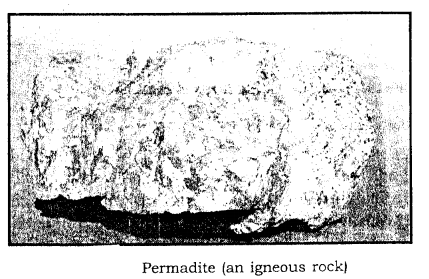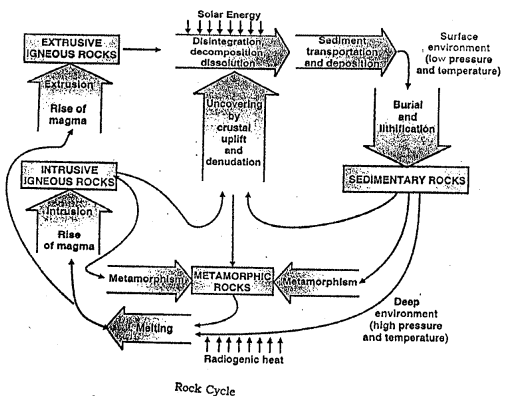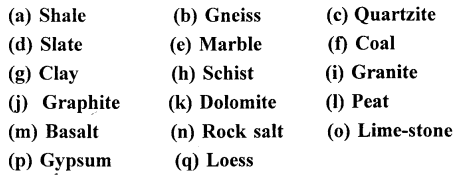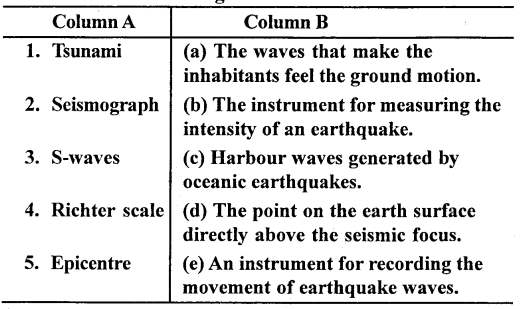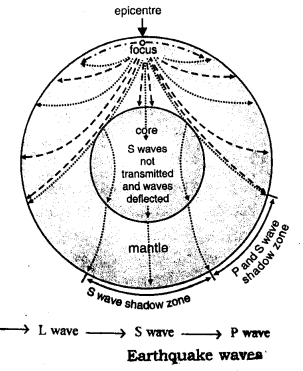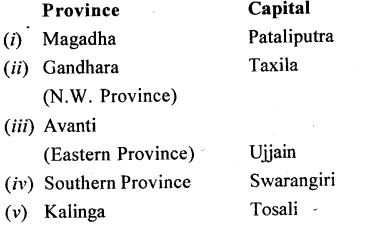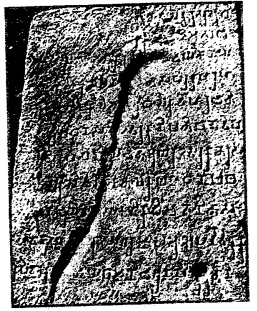ICSE Solutions for Class 9 Geography – Landforms of the Earth
ICSE SolutionsSelina ICSE SolutionsML Aggarwal Solutions
Exercises
I. Short answer questions.
Question 1.
What is meant by a landform ?
Answer:
A landform is a natural feature on the surface of the earth with a particular shape.
Question 2.
Why are the fold mountains called so ?
Answer:
Fold mountains are called so because of the result of large- scale earth movements caused by stresses in the earth’s crust. Such stresses may be caused by weight of the overlying rocks, movements in the mantle, the expansion or contraction of some part of the earth, etc. These stresses subject the rocks to compressive forces, producing wrinkling or folding along the lines of weakness. This is shown in fig. the raising of folds makes the fold mountains.

Question 3.
Give two chief characteristics of the fold mountains.
Answer:
- The fold mountain system has parallel ranges.
- A fold mountain region is also a region of sudden forces such as of volcanoes and earthquakes.
Question 4.
Give one example of each :
(a) Young fold mountains;
(b) Old fold mountain. Why they are called so
Answer:
(a) These mountains are made of light sedimentary rocks of recent tertiary age and are the highest mountain system which are still increasing their heights due to gradual upthrust force. The Himalayas are called young fold mountains.
(b) The Alpine-Himalayan system and Circum Parific mountain belt are the ‘Old Fold Mountains’ which existed as geosynclines 50-60 million years ago.
Question 5.
Give example of residual mountains.
Answer:
Examples of Residual mountains are Nilgiri, Parasnath and Rajmahal Hills in India and the Catskill range in the USA.
Question 6.
How is a rift valley formed ? Give one example of a rift valley.
Answer:
A rift valley is formed by the submergence of a big landmass between two high block mountains, e.g. the Rhine river flows through a rift valley in its middle course.
Question 7.
Give a brief definition of a plateau.
Answer:
The Himalayas are an important form of folding being the highest mountain range in the world.
Question 8.
Give one example of each :
(a) Intermontane plateau
(b) Volcanic plateau and
(c) Piedmont plateau
Answer:
(a) The Tibetan plateau
(b) The Plateau of Peninsular India.
(c) The Patagonian plateau of South America.
Question 9.
Give two points of importance of landforms.
Answer:
Various landforms display the internal and external forces of the earth, different climatic effects and features, forests, snow lands giving birth to rivers, coasts and islands as fishing regions. All these together make the earth beautiful and ideal for living and various activities.
Question 10.
What are known as epeirogenic movements ?
Answer:
The movements such as uplift and submergence working in vertical direction are known as epeirogenic movements. ‘Epeiros’ in Greek means continent ‘genic’ means building. As this movement created continents coming out higher from the oceans.
Question 11.
Name two landforms created by epeirogenic movements.
Answer:
- Block mountains.
- Rift valleys and basins are produced by epeirogenic movements.
Question 12.
Why are the sudden forces described as ‘Constructive forces ?
Answer:
Earthquakes and volcanic activities are described as sudden forces. These forces are described as ‘Constructive Forces’ because they create relief features on the surface of the earth. As volcanic erruptions result in the formation of volcanic mountains, extensive plateaus and also plains.
Question 13.
What are called endogenic forces ?
Answer:
Endogenic forces are the internal diastrophic forces working inside the interior of the earth related to the tectonic forces.
Question 14.
Name four relief features on the surface of the earth.
Answer:
The four major landforms are mountains, plateaus, plains, valleys and basins.
Question 15.
What are known as exogenic forces ?
Answer:
Exogenic forces work on the surface of the earth through water, wind and ice, resulting in changing the shape of landforms slowly.
Question 16.
Name the two land forms produced by exogenic forces.
Answer:
- Alluvial and erosional plains
- Glacial landforms.
Question 17.
Give one chief characteristic of the fold mountains.
Answer:
The fold mountains are formed by the lateral compression of sedimentary rocks as seen by the different layers of various types of rocks one upon another.
Question 18.
Give one example of volcanic mountains.
Answer:
Volcanic mountains are formed by erupting magma from the inner core on the surface e.g. Mt. Krakatoa is an active volcano on the western side of Java.
Question 19.
How is a rift valley formed ? Give one example.
Answer:
A rift valley is formed by the submergence of a big landmass between two high block mountains, e.g. the Rhine river flows through a rift valley in its middle course.
Question 20.
Give a brief definition of a plateau.
Answer:
A plateau is a higher tableland between mountain and valley, lower than mountain and higher than valley.
Question 21.
Give one example of each
(a) Intermontane plateau
(b) Piedmont plateau
(c) Volcanic plateau.
Answer:
(a) The Tibetan plateau.
(b) The Patagonian plateau of South America.
(c) The Plateau of Peninsular India.
Question 22.
How are erosional plains formed ?
Answer:
Erosional plains are formed by the agents of erosion in millions of years, when the higher landforms are eroded into level plain areas, e.g. Lorraine plain in France.
Question 23.
Give two points of importance of landforms.
Answer:
Various landforms display the internal and external forces of the earth, different climatic effects and features, forests, snow lands giving birth to rivers, coasts and islands as fishing regions. All these together make the earth beautiful and ideal for living and various activities.
II. Distinguish between each of the following
- Fold Mountain and Block Mountain.
- Intermontane plateau and Volcanic plateau.
- Structural plain and Depositional plains.
- Tectonic mountain and Volcanic mountain.
Answer:
1. Fold Mountain :
- Fold mountains is built by the tectonic forces folding the sedimentary rocks.
- These are formed of light sedimentary rocks e.g. the Himalayas
Block Mountain :
- Block mountain is built after the submergence of a landmass leaving behind the big blocks on the both sides.
- These are formed by solid rocks standing on the both sides of a rift valley. e.g. Vosges mountain in France.
2. Intermontane plateau : These are the highest and most extensive types on the globe surrounded by hills and mountains. The plateau of Tibet is the highest plateau as well as most extensive intermontane plateau. Other examples are Columbian Plateau, North Americal Cordillera, Bolivian, Peruvian and Mexican plateaus.
Volcanic Plateau : In places where fissure eruptions have taken place magma erupts quietly through narrow fissures several kilometres in length. This magma spreads on the surface and cools down as a sheet of lava covering the surface of the land. Eruptions at intervals lead to the piling up of lava sheets one over the other in a series of steps. The Deccan trap region of Peninsular India has several lava sheets having a maximum thickness of about 200 metres. This region forms a lava plateau. Other examples are South African plateau, Columbian Plateau and Ethiopian plateau.
3. Structural plain : It is formed by the uplift of landmass by Diastrophic forces creating an extensive lowland. The Missouri – Mississippi plain of U.S.A. is an example, which came out of ocean by uplift force.
Depositional plains : These plains are formed by the deposition of materials which have been brought by various agents of transportation, eg.
- River Deposition : The most widespread of these are alluvial plains like the Northern Plains of India; the flood plains like the Mississippi Plains in the USA, deltaic plains in Egypt and India
- Wind Deposition : Most of such plains are sandy deserts like the Sahara in Africa and the Thar desert in India. They have irregular and undulating surface made by existence of sand dunes and hallows.
- Marine Deposition : These plains are found in coastal regions. Examples are the east coast of India, the estuarine banks in the Netherlands, coast of Germany and Denmark.
4. Tectonic mountain :
- It is built by the tectonic force working on the crust of the earth.
- It is the result of upthrust force of the tectonic movement.
- It may be built by sedimentary or metamorphic rocks.
Volcanic mountain :
- It is built by the volcanic eruption from the interior of the earth.
- It is the result of upthrust force of magma coming up on the earth surface.
- It may be built by crystalline igneous rocks of particular composition.
III. Give one technical term for each of the following
Question 1.
Block mountains with flattened summits.
Answer:
Horst Mountains.
Question 2.
Plateaus surrounded by hills and mountains on all sides.
Answer:
Intermontane plateaus.
Question 3.
Plateaus formed by lava.
Answer:
Volconic plateaus.
Question 4.
An extensive area of lowland with a level or gently undulating surface.
Answer:
Plain.
Question 5.
The compressional forces that cause folding of rocks and formation of fold mountains.
Answer:
Diastrophic forces.
Question 6.
The vertical movements which are the result of faults and cracks in the surface of the earth.
Answer:
Epeirogenic forces.
Question 7.
The forces operating on the surface of the earth.
Answer:
Exogenic forces.
Question 8.
Plateaus surrounded by mountains on one side and plains on the other.
Answer:
Piedmont plateaus
P Q. Fill in the blanks with suitable words.
- Volcanic activity is a sudden movement.
- The upfolds of the rock strata are called anticlines.
- The Mid-Atlantic Ridge rises 3 km above the floor of the Atlantic.
- The Great Plain of the USA was formed by Diastrophic forces.
- The Great Northern plains of India were formed by River Deposition.
IV. Long Answer Questions.
Question 1.
1. Describe the formation of mountains and their types.
Answer:
Mountains are classified into three main types depending on the forces that have formed them. Three main types of mountains are
- Fold Mountains : Fold mountains are the result of large-scale earth movements caused by stresses in the earth’s crust. Such stresses may be caused by weight of the overlying rocks, movements in the mantle, the expansion or contraction of some part of the earth, etc. These stresses subject the rocks to compressive forces, producing wrinkling or folding along the lines of weakness. This is shown in fig. The raising of folds makes the fold mountains.

- Residual Mountains : Mountains which are subjected to weathering and erosion for a longtime, are lowered down and called residual or relict mountains.
Denudation and erosion by natural agents like winds, water, snow etc., cause the mountains to be lowered but some resistant areas may remain and form residual mountains.
They may also be formed on plateaus that are dissected by rivers. For example the hills and valleys in the Deccan plateau.
Some examples of Residual mountains are Nilgiri, Parasnath and Rajmahal Hills in India and the Catskill range in the USA.
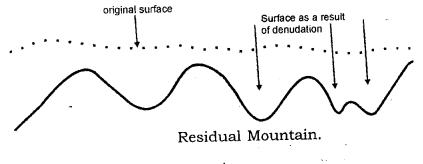
- Block Mountains : Horst or a block mountain is an uplifted land mass situated between two adjacent faults. The central block is upthrown or land on the outer-sides of the faults is downthrown so that the central mass appears like a highland. Its surface is like a plateau, but it has steep edges. The Vosges mountains to the west of the Rhine Rift Valley and the Black Forest mountain to the east of the Rhine Rift Valley are good examples of Horsts.
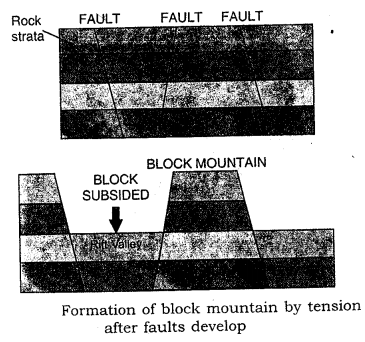
Question 2.
Describe the characteristics of four different types of plateaus.
Answer:
Intermontane plateaus are the highest plateaus between highest mountains, e.g. Tibetan plateau. Piedmont plateaus lie between mountains and plains with steep slopes towards plains due to the force of flowing water downwards, e.g. Appolochian plateau of U.S.A., Patagonia plateau of South America Volcanic plateaus are created by volcanic eruption and Lava flows, e.g. Deccan plateau of peninsular India Uplifted plateaus are caused by the endogenic forces resulting in the dome shaped plateaus e. g. Chhotanagpur plateau in India
Question 3.
Describe the characteristics of structural plains.
Answer:
Structural plains are created by uplifting of a large landmass due to Diastrophic movements, e.g. plainofU.S.A. Erosionalplains are formed by eroding highlands into plain areas, e.g. Lorraine plain in France. Srinagar Valley of Kashmir is the result of glacial erosion, Sahara desert plain is the result of wind erosion. Karst plains are created by erosion of limestone rocks by ground water, e.g. Karst plain of Yugoslavia. Depositional plains are caused by large scale deposition of debris and silt deposited by the running water or rivers, e.g. Northern plain of India.
Question 4.
Explain the chief characteristics of depositional plains and their types.
Answer:
Depositional plains These plains are formed by the deposition of materials which have been brought by various agents of transportation, eg.
- River Deposition : The most widespread of these are alluvial plains like the Northern Plains of India; the flood plains like the Mississippi Plains in the USA, deltaic plains in Egypt and India
- Wind Deposition : Most such plains are sandy deserts like the Sahara in Africa and the Thar desert in India. They have irregular and undulating surface made by existence of sand dimes and hallows.
- Marine Deposition : These plains are found in coastal regions. Examples are the east coast of India, the estuarine banks in the Netherlands, coast of Germany and Denmark.
Question 5.
Give a brief account of importance of landforms on the surface of the earth.
Answer:
Landforms play an important role for human activities by providing different aspects of landscapes, climatic variety, natural gifts of snowclad ranges, glaciers and rivers etc., various vegetation zones imparting innumerable forest’ products, agriculture and other occupations related to different types of landforms, natural beauty and tourism all these making this earth fascinating living world.
Practice Questions (Solved)
Question 1.
Describe the direction in which the following mountain systems lie and also point out the continents where they are found.
(a) Alpine Himalayan System
(b) Rocky-Andean System
Answer:
(a) Alpine and Himalayan System both run from West to East direction in Europe and Asia continents respectively.
(b) Rocky-Andean System both run from North to South in the western margins of North America and South America continents.
Question 2.
Describe the different stages in the growth of mountains.
Answer:
There are three different stages in the growth of mountains.
- The geosyncline stage : The deposition of sediments in the sea-bed to form large geosynclines.
- The Orogenic stage : The tectonic forces working horizontally push and press there geosynclines to form various folds.
- Epeirogenic stage : When the whole mass of geosynclines is raised and buckled up and form a distinct series of troughs (synclines) and arcs (auticlines) i.e. Mountains and Valleys.
Question 3.
What are the different types of Geosynclines ?
Answer:
There are three types of Geosynclines
- Monogeosynclines : Long, narrow geosynclines along narrow water bodies take the shape of narrow mountains such as Appalachian mountains of North America.
- Polygeosynclines : Geosynclines laid down in wide and long water basin take the shape of broad and long mountain ranges like Rockies in North America.
- Mesogeosynclines : The geosynclines lying between Europe and Africa continents resulted in various mountain ranges e.g. Alps and Pyrenees in Europe, Atlas in Africa.
Question 4.
Write a note on the characteristics of folded mountains.
Answer:
Folded mountains are formed by the forces of compression and contortion resulting in a series of synclines and anticlines, later on undergoing various erosive forces. All the highest mountain systems are example of folded mountains made of sedimentary rocks.
Question 5.
What are Block mountains ? How are they formed ?
Answer:
Block mountains are formed on the both sides of a rift valley, which is formed by deep submergence of a large landmass leaving behind two raised platform type blocks known as Block mountains. These landforms are created by displacement of landmass along fault lines known as faulting.
Question 6.
How can mountains be classified according to their different size and arrangement ? Describe in detail two of the classes of such mountains.
Answer:
Simply the mountains can be divided into 4 groups
- Folded mountains
- Block mountains
- Volcanic mountains
- Relict mountains
Volcanic mountains : are formed by the eruption and deposition of magma from the interior core to the land surface. According to their construction these are Cinder or Ash cones, Lava cones and composite cones, e.g. Fujiyama in Japan.
Relict mountains : These are formed by the continuous erosion ofthe original materials and giving birth to the hills of rounded peaks made of high density rocks, which have undergone excessive pressure and denudation by natural agents. One of the best example is Vindhyanchal mountain.
Question 7.
What are Block mountains ? How are they formed ?
Answer:
Horst or a block mountain is an uplifted land mass situated between two adjacent faults. The central block is upthrown or land on the outer-sides of the faults is downthrown so that the central mass appears like a highland. Its surface is like a plateau, but it has steep edges. The Vosges mountains to the west of the Rhine Rift Valley and the Block Forest mountains to the east of the Rhine Rift Valley are good examples of Horsts.

Question 8.
How can mountains be classified according to their different size and arrangement ?
Answer:
Mountains can be classified according to their different size and arrangement as given below :
- CordillersThese are large regions of mountains topography which are characterised by a large number of chains and ranges.
- System It is formed of several associated ranges. These ranges should be similar in position, form and structure although treanches or basins may separate them.
- ChainIt is a series of ridges in one line although separated by trough like valleys.
- RangeIt is a linear arrangement consisting of a large number of peaks and ridges separated by valleys. The different mountains possess a unity of form and structure.
- Group It is a circular or massive arrangement of peaks and ridges. Group formations often result from the erosion of laccolths.
- Ridge It is the individual arch or block that results from folding and faulting. It may be of various types according as the slope is steep on one side or the other.
- Peaks These are formed by the less regular beds resisting denudation. They may be dome-like or pyramidical or needle-shaped. Their shape depends upon the rock structure and joint planes of the region. The peaks and ridges may either be arranged parallel to one another or may be quite isolated of may be arranged like features round a dome or they may be cones formed due to volcanic extrusion.
Question 9.
What are plateaus ? How are they different from mountains ? Give suitable examples.
Answer:
Plateaus Plateaus or table lands are elevated uplands, extensive in size and descending steeply to the surrounding regions. On the other hand, a portion of land surface rising considerably above the surroundings either as a single eminence or in a range if chain is called a ihountains.
Examples of Plateaus :
- Deccan Plateau of India.
- Tibetan Plateau (called the roof of the world)
Question 10.
What is a Piedmont Plateau ? How is it different from a Continental plateau ? Give suitable examples to illustrate.
Answer:
Piedmont Plateaus The plateaus which lie at the foot of the mountains are called Piedmont plateaus. These are flanked on one side by the plains or seas. The chief examples are the Colorado plateau or North America and the Patagonia Plateau of South America. Continental Plateaus The extensive and massive tablelands which rise abruptly from the bordering lowlands or from the sea are called continental plateaus. On most of their margins, there is sea. They seldom have mountainous rims. The major portion of Africa, Arabia, Spain, Australia, Peninsular India, Greenland and Antarctica are continental plateaus.
Question 11.
Write short notes on the following :
(a) Coastal plains
(b) Karst plains
(c) Peneplain
(d) Cuestiform plains.
Answer:
(a) Coastal plains : The plains situated near a sea coast are called coastal plains. They are formed by the sea waves after sea bottoms have emerged. The newly emerged plain is generally broad and wide and comprise of loosely compacted layers of mud and sand. Many coastal plains increased in which towards the sea because the sea waves continue adding matter to it.
(b) Karst plains : These plains are formed by the action of underground water, dissolving the regions made of chalk or limestone are called Karst plains. They are often flat-bottomed. Due to wind erosion and differential weathering, the topography is etched and rounded or even polished in a curious manner. Some of the relief features are quite fantastic in shape, especially the pebbles and other fragments that litter the surface of these plains.
(c) Peneplains : Very low undulating plains are called peneplains. They are almost plains.
(d) Cuestiform plains : The plains marked by a concentric arrangement of ridges and lowlands are called Cuestiform plains. Paris and London are the typical examples of such plains. They are made by river action on hard and soft rocks. Consequently they become rolling like the downs of S.E. England.
Question 12.
Why and how are the plains the centres of all human activity ?
Answer:
The plains are the centres of great economic advancement. The alluvial plains have been the cradles of civilisation from the earliest time. They have the following advantages to man:
- Railways, roads and waterways can be easily laid.
- They are the granary of the world.
- Due to fine climate, fertile soil and facilities for movement, the plains have become thickly populated and most of the big cities and towns are situated in the plains of the world except in areas which suffer from harsh climate and temperature.
Question 13.
Differentiate between Young fold mountains and Old fold mountains.
Answer:
Old fold mountains : The fold mountains which were formed about more than 250 million years ago are called old fold mountains. For example, the Urals in Russia, the Appalachians in North America and the Aravalli range in India are old fold mountains. These mountain ranges are of low altitude and have gentle slopes.
Young fold mountains : The most recent phase of mountain building took place about 25 million years ago. The world’s highest mountain ranges were formed during this period. These are known as young fold mountains. They have rugged relief features because they have been subjected to denudation for a comparatively short period only.
Question 14.
Give reasons for the following :
- Old fold mountains have low altitude and gentle slopes.
- Young fold mountains have rugged relief features.
- Young fold mountains are liable to Earthquakes and Volcanic action.
Answer:
- Old fold mountains have low altitude and gentle slopes because they have been subjected to denudations for million of years.
- Young fold mountains have rugged relief features because they have been subjected to denudation for a comparatively short period only.
- Young fold mountains are liable to Earthquakes and volcanic action because these mountain regions are areas of crustal instability.
Question 15.
State two evidences that the Earth movements have taken place in the past.
Answer:
The evidences that the Earth movements have taken place in the past are as follows :
- The basins containing sedimentary rocks indicate that such basins must have been below sea level in the past. The coalfields of the Damodar valley occur in such basins of the geological past.
- Oilfields occur in basins containing old sedimentary rocks. Such basins are now occurring on the land. This shows that the portion of the crust which was once depressed must have been uplifted later.
- llie Himalayas provide another evidence of the recent effect of Earth movements.
Question 16.
What causes Orogenic movemeiits ?
Answer:
Orogenic movements are caused by compressional or tensional forces.
Question 17.
What are the effects of Epeirogenic movements ?
Answer:
Effects of epeirogenic movements :
- They cause rising or sinking of the crust. They may cause the elevation of broad areas as extensive as those of a continent or lowering of the sea level.
- These movements are responsible for the formation of plateaux.
